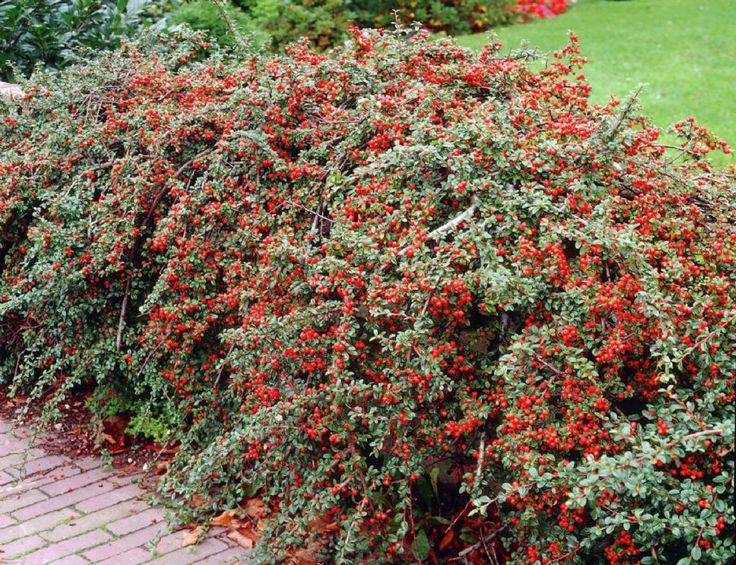Cotoneaster Hedge

Cotoneaster hedge
Easy to grow, Hedge Cotoneaster is ideal for pruning and manipulating into geometric shapes. The shrub is densely branched, so it makes an excellent cut hedge. Grows up to 6-10 ft. tall and wide (180-300 cm).
How tall does cotoneaster get?
Its mature height is 5 to 7 feet and is slightly taller than broad. Its slender canes grow up and out with a spread of 4 to 6 feet. Cotoneaster grows slowly at first, but after a couple years develops at about 12 to 18 inches per year. Cotoneaster is appreciated more for its dark green foliage than its blossoms.
Can cotoneaster be cut back hard?
Pruning cotoneaster Evergreen species are best pruned at the beginning of spring to shape and balance the shrub to your taste. Cotoneaster can bear pruning well. If need be, hack away at it with severe pruning since the shrub can take it without a fuss. Just try to remain within this “early Spring” time frame.
Where is the best place to plant a cotoneaster?
Cotoneasters thrive in moist but well-drained soil, in full sun to partial shade. The best time to plant a cotoneaster is in autumn, when the soil is still warm from summer but moist enough for the roots to establish before winter sets in.
Is cotoneaster poisonous to dogs?
Dogs and cats often remain well following ingestion of Cotoneaster berries, but gastrointestinal signs may occur. There is a potential for cyanogenic glycoside toxicity if a large quantity has been ingested, but severe Cotoneaster poisoning is rare and more likely to occur in herbivores.
Do cotoneaster lose leaves in winter?
This shrub is deciduous so it will lose all its leaves in autumn, then fresh new foliage appears again each spring. The glossy dark green leaves of this small, spreading, deciduous shrub are studded with tiny, pinkish-white flowers in May, followed by bright red autumn berries.
How far apart do you plant cotoneaster for a hedge?
Plant the shrubs 12 to 18 inches apart. A more relaxed approach is to plant them further apart -- up to 4 feet -- for an informal hedge. They get taller, six or seven feet, but are a lot looser. You can also go for the "dotted line" effect, and put them about 8 feet apart.
Does cotoneaster like sun or shade?
CARING FOR COTONEASTERS Provide full sun or partial shade as noted. They'll thrive in fertile soils but tolerate any soil as long as it is well-drained.
What is the best cotoneaster for hedging?
Cotoneaster Hedge Height, Growth and Pruning Franchetti, lacteus and horizontails are the perfect choices if you're looking to grow a hedge between 1m-2m tall. All three types will typically grow at around 20-40cm per annual.
Are cotoneaster roots invasive?
Eradication Cotoneaster species can be difficult to eradicate because they are often invasive in areas where there are complex plant associations, making it difficult to eradicate only the target plants and not those nearby, combined with the fact that they have tough roots, making them difficult to dig up.
Is cotoneaster invasive?
Cotoneaster—an invasive woody shrub with red berries that are readily dispersed by birds—forms dense stands that block all light to the understory.
Is cotoneaster plant invasive?
Cotoneaster was introduced to the UK in 1879 from Eastern Asia as an ornamental plant. It is now an invasive non-native species which is taking over valuable habitats including limestone grasslands.
Does cotoneaster attract bees?
Cotoneaster splendens is known for attracting bees and birds. It has nectar/pollen rich flowers, is used for nesting materials and provides shelter and habitat.
How long does cotoneaster live?
In coastal Northern California there is a lot of Cotoneaster growing as an invasive, but I'm not sure of the specific species. I've seen many that are well over 30 years, and some that are thick enough at the base that 40-60 years would be entirely unsurprising.
Is cotoneaster a tree or shrub?
Cotoneaster plants can be small trees, shrubs and ground cover, with some varieties suitable for training flat against a wall or used as hedging.
Will deer eat cotoneaster?
Covered with small, pink or white flowers resembling opening rose buds in spring, many deciduous cotoneasters also boast brilliant fall color in glowing shades of orange, red, and purple. Tough, easy to grow and deer resistant landscape plants.
What does cotoneaster smell like?
The flowers, when inhaled near to, have an unpleasant smell like decaying fish[245]. They are very attractive to bees whilst the fruit is a good winter food source for many species of birds[200].
What happens if you eat cotoneaster berries?
Its bright orange berries grow in clusters so thick that the branches cannot be seen. Cotoneaster is poisonous in large amounts and may cause trouble breathing, weakness and seizures.
Is cotoneaster frost hardy?
Although Cotoneasters are frost hardy when they are planted into the ground, they should be protected from frost when they are planted in small containers. The Cotoneaster needs a lot of water in summer, but it can survive short droughts.
How do you maintain cotoneaster?
And I'm going to talk about how to prune Buitoni asters. The thing about Katonah asters is a water









Post a Comment for "Cotoneaster Hedge "